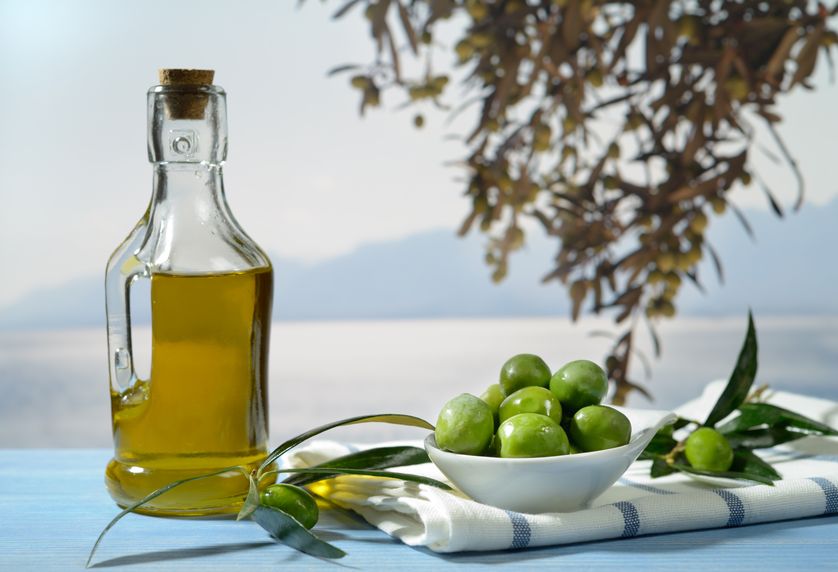Growing up, the only oils I remember my mom using were Canola or Olive Oil. Now, I could pick an “oil of the day” or one to suit my mood if I wanted. The grocery store shelves are full of so many different types: walnut, canola, sesame, avocado etc. The Media loves confusing us by saying that Olive Oil is great for heart health, yet it becomes unhealthy when you cook with it. We hear that coconut oil is great, but it’s a saturated fat. Aren’t saturated fats “bad”? What should we believe? Today, I’m going to dive into the variety of oils that are available and let you know which ones are best for which purpose.
Before we begin, let’s discuss some key factors pertaining to oils: smoke point, omega-3, omega-6, omega-9, mono-unsaturated, poly-unsaturated, and saturated fat.
Smoke Point– This is refers to the temperature at which oil starts to break down. Oils with high smoke points are good for frying or high-heat stir-frying, while oils with low smoke points are better used in salad dressings, for dips, or as finishing oil.
Omega-3 fatty acids are considered essential because your body cannot make them on its own. They must be obtained through food sources or supplements. Omegas 3s are essential for brain function (memory and performance) as well as normal growth and development. The American Heart Association touts its benefits for reducing risk of heart disease. Omega-3s are found most abundantly in fish (salmon, halibut, tuna). Algae and Krill are other good sources as well as some plant and nut oils. One key benefit of Omega-3 fatty acids is its ability to reduce inflammation. This may help reduce risk of chronic diseases such as heart disease, arthritis, and cancer.
Omega-6 fatty acids are also essential for brain function. Unlike Omega-3s, the average American consumes more than enough omega-6 fatty acids (14-25 times more omega-6 than omega-3). For optimal health, it is important to have the proper ratio of omega-3 and omega-6) in the diet. Omega-3 fatty acids help reduce inflammation and most omega-6 fatty acids tend to promote inflammation. Research suggests that higher dietary omega-6 to omega-3 ratios appear to be associated with worsening inflammation over time and a higher risk of death among hemodialysis patients.

Good Oil!
According to Artemis Simopolous, MD and Director of the Center for Genetics, Nutrition, and Health in Washington D.C., “The ideal ratio is one to one or two to one, omega-6 to omega-3,” Unfortunately, the American diet has been flooded with omega-6 fatty acids, mostly in the form of vegetable oils such as corn oil and safflower oil.”
Monounsaturated Fats (MUFA)– According to the American Heart Association (AHA), chemically, monounsaturated fats are simply fat molecules that have one unsaturated carbon bond in the molecule (aka: a double bond.) Oils that contain monounsaturated fats are typically liquid at room temperature but start to turn solid when chilled. Monounsaturated fats can help reduce LDL (“bad”) cholesterol levels in your blood which can reduce risk of heart disease and stroke. They also provide nutrients to help develop and maintain your body’s cells. Oils rich in monounsaturated fats also contribute vitamin E to the diet, an antioxidant vitamin most Americans need more of.
The AHA states that, “By substituting monounsaturated fat in your diet for saturated and polyunsaturated fats you may be able to keep HDL cholesterol levels high and LDL cholesterol levels low. Overall the highest intake of fat should be from the monounsaturated type (12 – 20 percent of total calories).”
Polyunsaturated fats (PUFA)– Chemically, these fats contain more than one double bond. They, like monounsaturated fats are typically liquid at room temperature but start to turn solid when chilled. These also can help reduce LDL levels in your blood they provide nutrients to help develop and maintain your body’s cells. Oils rich in polyunsaturated fats also provide omega-6 and omega-3 fatty acids.
Saturated Fats– The American Heart Association states that the majority of saturated fat comes from animal products such as beef, lamb, pork poultry with skin, butter, cream, cheese and other dairy products made from whole or 2 percent milk. All of these foods also contain dietary cholesterol. Foods from plants that contain saturated fat include coconut, coconut oil, palm oil and palm kernel oil and cocoa butter. For people who need to lower their cholesterol, the American Heart Association recommends reducing saturated fat to no more than 5 to 6 percent of total daily calories.
Now it’s time to explore the oils!
Let’s start with the most common:
Olive Oil- Everyone sings the praises of this King of Oils! This is a heart-healthy staple of the Mediterranean diet and is made from ripe olives. “Extra virgin” is made from the first pressing of olives. “Light” olive oil is lighter in flavor and color but has the same amount of calories as extra-virgin. It is great as a dipping oil, a dressing, or a finishing oil. There has been debate as of late about whether or not olive oil is safe to cook with. The general consensus seems to be that extra-virgin olive oil should be saved for dressings and dipping due to its lower smoke point. After 375⁰-405 ⁰, toxic chemicals are formed. Around 356 ⁰ olive oil begins to lose some of its antioxidants. It is ok to lightly sauté over medium heat or roast up to 350⁰. Refrain from frying or other high heat cooking.
Vegetable Oil is often made from a blend of soybean and other oils; vegetable oil contains primarily polyunsaturated fats and considerable monounsaturated and saturated fat. This thought of as an all-purpose oil due to its neutral flavor and high heat tolerance. It can be used in baking and sautéing.
Canola Oil was first introduced in the 1970s for home cooking and is made from seeds of the canola plant. This, like vegetable oil is quite versatile and can be used for baking, sautéing and frying. It is neutral in flavor.
Coconut Oil is extracted from the fruit of mature coconuts and is a saturated fat. Virgin coconut oil is high in lauric acid, a medium-chain fatty acid. Preliminary studies show that this acid may have a neutral or beneficial effect on cholesterol levels. Coconut oil has a sweet flavor and is often substituted for shortening or butter in vegan recipes. It imparts a tropical flavor to vegetables, curry dishes and fish. Many have deemed this as a “superfood,” but medical professionals recommend keeping intake to a minimum, as this is a saturated fat. Enjoy a tablespoon in your smoothie or use it in curries. For those trying to reduce cholesterol levels, it is recommended to keep saturated fat intake to no more than 7% of fat intake. This happens to be one of my favorite oils. It serves as an excellent moisturizer as well!
Grapeseed Oil is extracted from grape seeds during the wine making process. It is high in polyunsaturated fatty acids, which has cholesterol-lowering benefits. Grapeseed oil has a moderately high smoke point, which makes it suitable for sautés and frying. It can also be used in dressings.
Now we’ll explore some that you might have seen but haven’t yet tried
Avocado Oil– This oil is comprised of more than 70% monounsaturated fatty acids, which makes it exceptionally beneficial for heart health. It has a unique flavor and makes an excellent addition to dressings or sautés.
Sesame Oil is rich in mono- and polyunsaturated fatty acids. Sesame oil is typically used in Asian cuisines and has a sweet, nutty flavor. It is great in stir-fry. Toasted sesame seed oil has a more intense flavor and aroma. Drizzle it over an Asian cabbage slaw with a sprinkle of black sesame seeds.
Walnut Oil is extracted from dried and cold-pressed nuts. This is beneficial for heart health because it has a high concentration of alpha-linolenic acid (ALA) that partially converts to omega- 3 fatty acids. It has a rich, nutty flavor that works well as a dressing or flavor enhancer. Avoid cooking with it and be sure to store this oil in the refrigerator.
Pumpkin Seed Oil also has a rich, nutty flavor, and is deep in color. This oil also has a high ALA content, though not as much as in walnut oil. It is also a good source of Vitamin E. This oil is best a drizzled over squash soup or create a flavorful salad dressing.
Peanut Oil is a common monounsaturated fat and like Pumpkin Seed Oil, it also contains vitamin E. This oil is often used in deep frying because of its high smoke point, while its distinctive flavor makes it shine in stir-fries and ginger dressing. Use it to make your own natural peanut butter by blending 2 Tbsp oil with 1 cup of peanuts in a high-powered blender or food processor.
Flaxseed Oil– You’ve probably heard of the benefits of flaxseeds, but were you aware that you could get the extracted oil too? Flax oil is comprised ofomega-3, omega-6 and omega-9 essential fatty acids. Some prefer to use flax instead of fish oil but it doesn’t provide the same omega-3 benefits that fish oil does. Flaxseed oil has a low smoke point, so it’s not ideal for cooking. Keep it refrigerated. You could add a tablespoon to your morning smoothie but I recommend consuming it as ground flaxseeds (flax meal) to reap the fiber benefits!
Sunflower Oil provides a good source of monounsaturated fats when you chose the “High Oleic” version. Standard sunflower oils are high in polyunsaturated fatty acids. Unrefined sunflower oil breaks down at high temperatures so use it for dressings. However, refined sunflower oil has a higher smoke point and neutral flavor and color, which makes it a great option for high-heat cooking such as baking, frying or sautéing.
Quite honestly, when I sauté veggies or do stir-fry I prefer to use chicken or vegetable broth and then drizzle on the oil right before I eat it. This way, I’m sure not to denature/over cook the oil but the real reason I do this is because I can best taste the flavor of the oil without adding too much! I do love a little olive or coconut oil drizzle on roasted veggies too…especially roasted cauliflower J Even though oils are beneficial, they should be consumed in moderation as part of a balanced diet. Two teaspoons to one Tablespoon is an appropriate serving with each meal. If you usually have olive oil on your salad, try using walnut oil and add some crushed walnut halves with a few dried cranberries and goat cheese!
Try this unique recipe using avocado oil as a base for pesto from Food52.com.
Avocado Oil Pesto Chicken
Serves 6-8
- 7tablespoons chopped cilantro
- 4cloves garlic, crushed
- 1lemon
- 1cup avocado oil
- 1/4cup unsalted peanuts
- 6-8pieces of dark meat chicken
- Squeeze the juice of half the lemon in food processor. Set aside the other half of the lemon for cooking with the chicken. To optimize the amount of juice that you can squeeze from the lemon, roll it back and forth a few times under the palm of your hand to get the juices flowing.
- Crush the garlic by placing the whole unpeeled clove under the flat side of a large wide knife and, using the palm of your hand, press the blade down on the clove, crushing it and splitting the skin. Peel the garlic, discarding the skin, and add that to the processor.
- Add the chopped cilantro and peanuts to the food processor and chop until all ingredients are combined.
- With the food processor on, slowly drizzle in the avocado oil until combined.
- Pour over chicken and rub under the skin of the chicken, add slices of the lemon around and bake uncovered for 1 hour at 375 degrees.
Resources:
http://umm.edu/health/medical/altmed/supplement/omega3-fatty-acids
http://food52.com/recipes/17949-avocado-oil-pesto-chicken
http://www.foodandnutrition.org/January-February-2014/All-About-Oils/
https://www.foxnews.com/food-drink/myths-about-olive-oil
http://www.todaysdietitian.com/newarchives/040114p20.shtml











